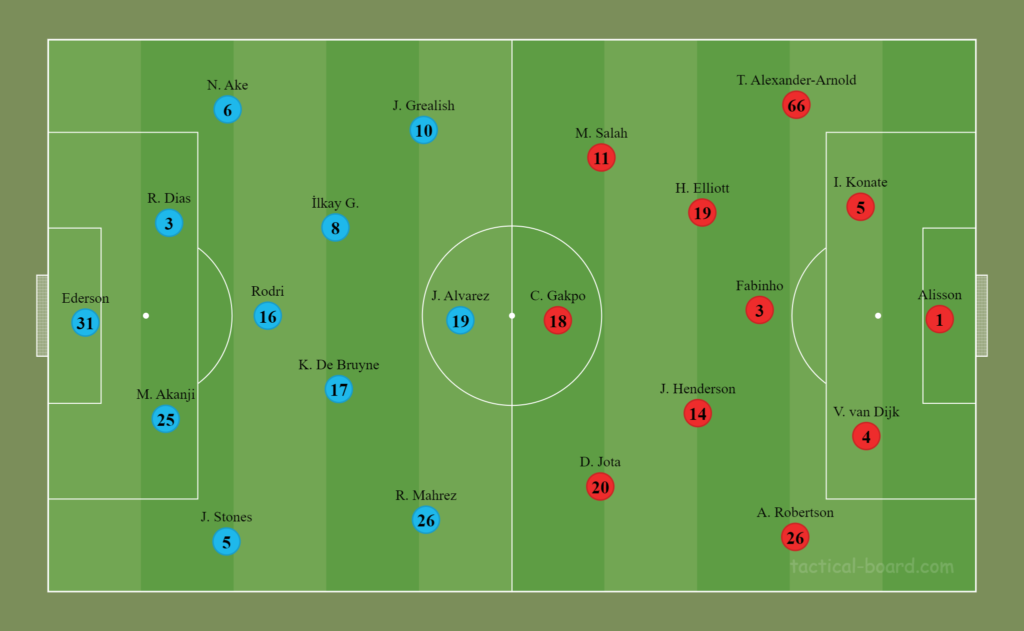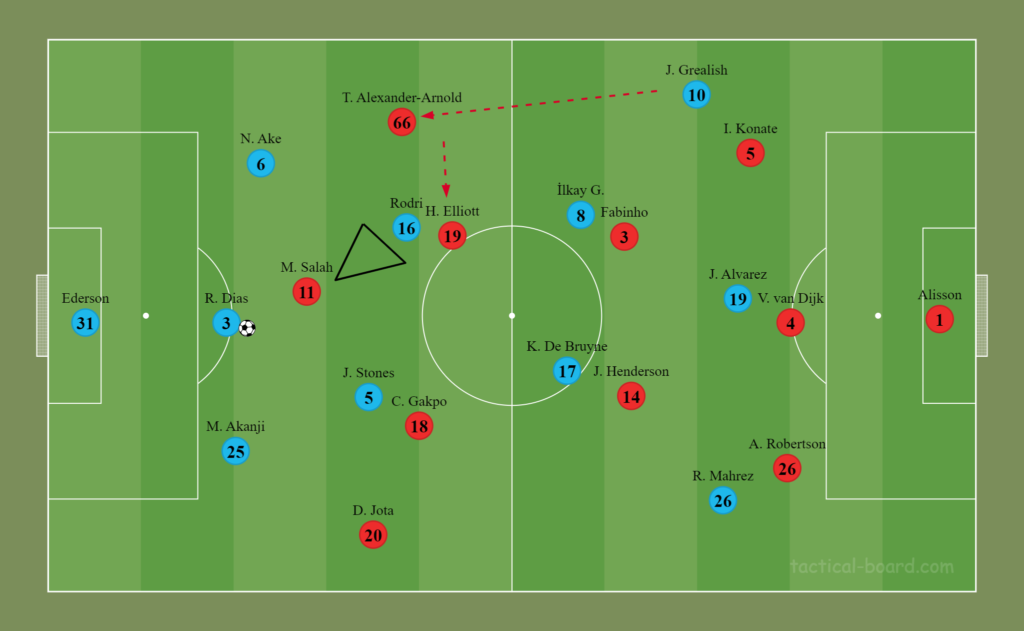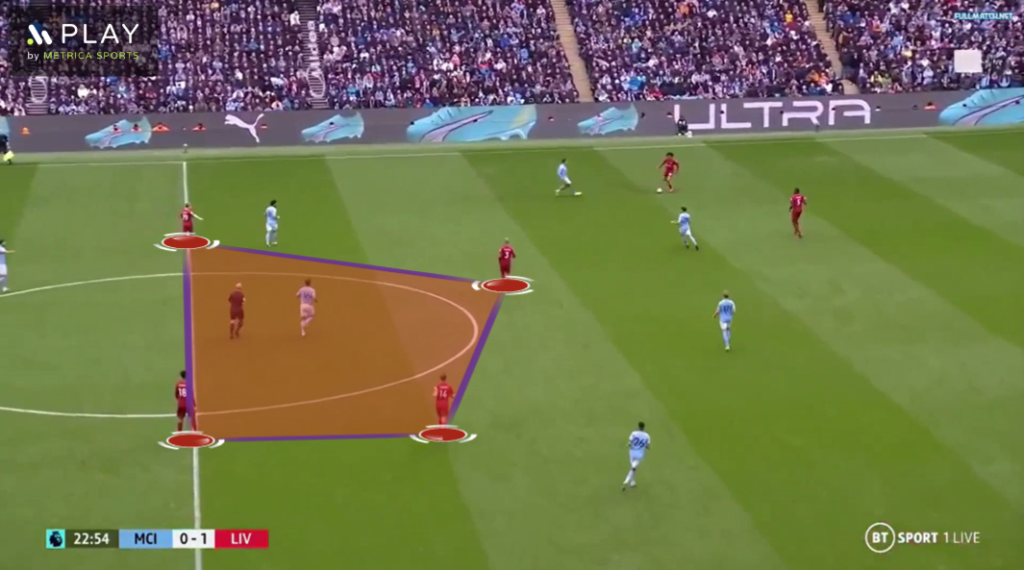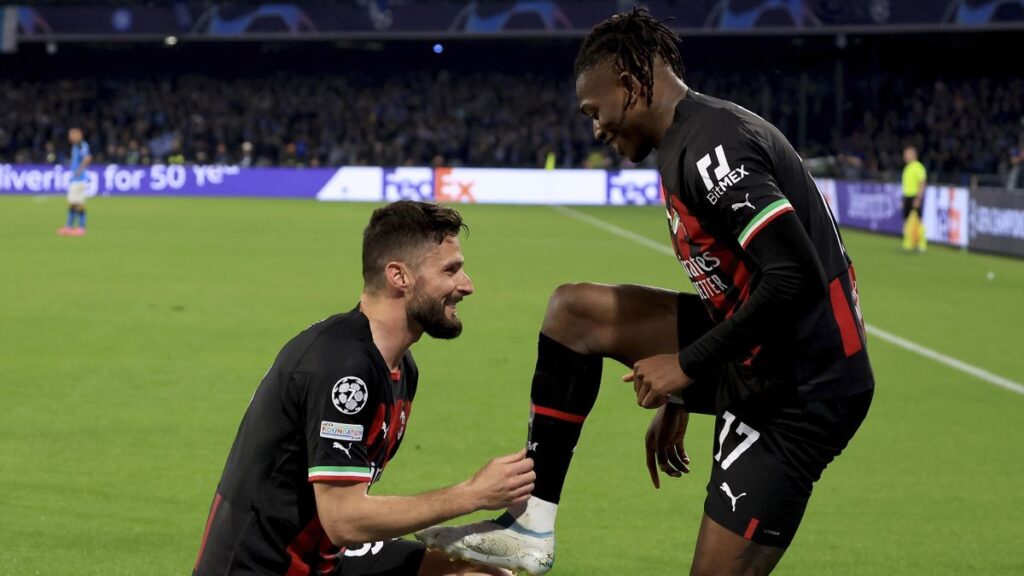In the match of the week in the Premier League, Manchester City, who are in the race for the title, and Liverpool, who want to claim that Champions League spot, faced each other. Liverpool scored the first goal, however Manchester City was the dominant side and emerged victorious with a score of 4-1 ,preventing the points difference between Arsenal from increasing. Liverpool's poor run of form after the 7-0 win over Manchester United continued. Erling Haaland did not play due to an injury and the starting 11s of the two teams were as follows:

MANCHESTER CITY IN POSSESSION
Despite pressing high throughout the whole game, Liverpool was unable to prevent Manchester City from dominating possession, with 68%. The away side, just like their other matches this season, did not show enough aggression while defending and as a result Manchester City had little trouble during the build-up . When Liverpool applied pressure right from the kick-off, Ederson played like a left centre-back to support the build-up.

Liverpool starts to apply pressure up high, as a result, goalkeeper Ederson acts as a left centre-back
3-2-2-3 formation IN the build-up
When Manchester City moved the ball forward, they switched to a 3-2-2-3 formation (which they have used often this season). Right-back John Stones was positioned next to Rodri, creating a square-shaped formation in the middle. For Liverpool, Salah and Gakpo marked the opposition's pivots, while Jota and Eliott paired-up with the wide centre-backs. When pressing, Liverpool lined up in a 4-2-4 formation with Jota and Eliott forcing the ball to R. Dias when the wide centre-backs received the ball. When the ball came to R. Dias, one of the players from the Salah-Gakpo duo would apply cover-shadow on the pivot and would press R. Dias. The pivot would be marked by Fabinho or Henderson (who normally mark the opposition number 8s), leaving KDB or Ilkay free between the lines. The Manchester City midfield was able to get to the free pivot in different ways throughout the match, such as the use of the 3rd man, and had no problems with the build-up. When the ball came to the free pivot, he would quickly pass the ball (as Henderson/Fabinho applied pressure) to the number 8 (KDB/Ilkay) who was free up front, allowing Manchester City to break the opposition's pressure.

Salah goes out to press with Rodri behind him. Meanwhile, Fabinho, who normally marks Ilkay, moves towards Rodri, who is free. Thanks to the use of the 3rd man, Manchester City get the ball to Ilkay, who is wide open

If Liverpool is able to create matchups in the midfield, Alvarez drops deep and helps during the build-up

During this situation in the 20th minute, the match-ups are very clear. Jota and Eliott are paired with the opposition's wide centre-backs. In midfield, there are the Ilkay-Fabinho and Henderson-KDB match-ups. Salah goes out to press while also applying cover shadow on Rodri. Stones comes out of the space blocked by Gakpo to become a passing option and the ball reaches Rodri, the 3rd man

Then Henderson leaves De Bruyne and applies pressure on Rodri, leaving De Bruyne free . This time Alvarez digs deep, acts as the 2. man and passes the ball to De Bruyne. De Bruyne passes to Grealish and Manchester City successfully move the ball into the final third

In this position, Ake is the player in possession. H. Eliott directs Ake towards the center. Ake's pass is received by R. Dias

Just like the previous situation, Salah goes out to press with Rodri behind him. Stones goes deep and passes to Rodri
Stones and Alvarez deserve a special mention here. Stones, despite originally being a centre-back, had no problems in the midfield and his ability to play in different positions allowed him to rotate frequently with his teammates, giving City great fluidity and flexibility in the collective play. Alvarez, unlike Haaland, often dug deep and kept the ball in Manchester City's possession on many occasions. In fact, the 2nd and 3rd goals came as a result of Alvarez going deep and contributing to the pass exchange. In some situations, we saw De Bruyne and Ilkay making runs into the space created by Alvarez dropping deep. It is a great advantage for Manchester City that his passing technique is at such a high level just like his finishing. It is undeniable that these two players added variety to City's collective play.
MANCHESTER CITY'S 1ST GOAL
During the home team's first goal, we saw a different template of play. Throughout the match, Ilkay and De Bruyne positioned themselves wider than their normal positions when the ball was received by the wide centre-backs(Ake-Akanji). This freed them from the marking of Henderson/Fabinho, making them helpful during the build-up . In these moments, if KDB/Ilkay received the ball, a player from the Liverpool defensive line would come out to apply pressure. In other words, Liverpool would lose one player from their defensive line. This is how Manchester City scored their first goal:

De Bruyne, seeing Dias' pass to Akanji, quickly moves towards the flank and evades Henderson's marking

Seeing De Bruyne open, Akanji passes the ball to the Belgian. With Henderson unable to reach the ball, Robertson leaves Mahrez free and moves towards De Bruyne to apply pressure on him. De Bruyne passes to Mahrez

As a result, Manchester City gain a 4-3 numerical advantage in the final third. Later during the attack, Mahrez moves towards the inside with the ball

Alvarez's shot after a series of passes results in the equalizer
LIVERPOOL'S CHANGING PRESsing formation
In the second half, we saw a different pressing formation from Liverpool. Klopp must have realized that one of City's No.8s was left open during the press, so he stopped commading Henderson and Fabinho to press the opposition pivots. Instead, H. Eliott shifted inside from the right flank with Trent Alexander-Arnold applying pressure on Ake. After this change, other problems arose for Liverpool. When Trent moved forward, the Liverpool defenders, who were left in a 3v3 match-up against the opposing attackers, struggled to prevent Manchester City's front three from receiving the ball. In one of the moments where City was able to get the ball to the front three, the hosts scored their second goal:

Liverpool's pressing formation in the 2nd half. Rodri, freed by Salah going out to press, is marked by H. Eliott, while Ake is marked by right-back Trent. As a result, City's attackers and Liverpool's defenders match-up 1v1

The H. Eliott-Rodri and Trent-Ake match-ups are clearly seen. R. Dias plays a long ball, but the ball bounces off and is retrieved by Ake

Trent can't intercept Ake's pass to Grealish and Grealish receives the ball on the left flank

As a result of the 1v1 match-ups, there is a gap in the middle of the defence and De Bruyne runs into it. Mahrez receives the ball after a great pass from Alvarez. Henderson doesn't follow De Bruyne's run and the Belgian crosses the ball into the net
MANCHESTER CITY'S ORGANIZATIONS on the wing
When Manchester City settled in the opponent's half, De Bruyne and Ilkay joined the attacking line and the home team lined up in a 3-2-5 formation. In this way, the attacking line had numerical superiority with 5 players against the opponent's 4 defenders. At the same time, there was a 3-man rest-defense structure at the back when attacking. Liverpool, on the other hand, faced their opponents in a 4-2-3-1 (4-4-2 with Gakpo shifting next to Salah from time to time) formation in the second third. Although Liverpool was quite compact, City players had enough time and space in the midfield. This was due to Liverpool's lack of aggression (especially in the second half). The Liverpool players were not able to support their narrow structure with aggression, which resulted in big gaps on the flanks. Manchester City players exploited these gaps (due to the lack of pressure on them) with diagonal passes to Mahrez/Grealish. When these players received the ball in the final third, we saw different attacking combinations. If Mahrez received the ball out wide and dribbled the ball inside, De Bruyne overlapped from the wing and if he received the ball he would cross inside from the right wing. On the left flank, Grealish would keep the ball at his feet for a while. In this way, the Englishman drew opposition players to him and created space for his teammates to exploit. Grealish, who in addition to his contribution on and off the ball, also boasted a goal and and assist, was probably the player of the match.

Liverpool's 4-2-3-1 formation in the second third. Although they looked very compact, they were not aggressive enough, especially in the second half, and the home team's midfielders had no trouble receiving the ball

In this situation we see Mahrez receiving the ball on the right flank. He keeps the ball at his feet for a moment for De Bruyne to overlap, and then he passes the ball to the Belgian for him to cross

We can clearly see the 3-2-5 formation that Manchester City uses in the second and final thirds. The striking thing here is that there is no pressure on Stones who receives the ball in the midfield. Making good use of the Liverpool players' mistake, Stones the ball to Mahrez with a diagonal pass and takes his team into the final third. In the following attack, City score the 3rd goal

Here we see Ilkay dropping deep and receiving the ball. He has enough time and space for a diagonal pass to Grealish who is isolated on the left flank.

Ilkay's pass is received by Grealish. Kevin De Bruyne's positioning gives the City players a 2:1 numerical advantage over Trent. Running into the half-space, De Bruyne receives the ball and crosses to Grealish who has cut inside. Grealish shoots for City's 4th goal
LIVERPOOL IN POSSESSION
Manchester City, unlike their opponents, were very aggressive when pressing high and prevented Liverpool from building-up play from their own third. The hosts forced their opponents to play long on several occasions and used an interesting pressing formation. Under pressure, Alvarez applied pressure on the the right centre-back and Mahrez to the left centre-back. Grealish matched-up with Trent, while right-back John Stones came forward from the defensive line to mark Robertson. If Manchester City forced the opposition to build-up play from the right, Stones would leave Robertson and return to the defensive line. When Alisson had the ball, City's central trio would close in on the opposition midfield. When the ball came to Liverpool's centre-backs, Alvarez or Mahrez would direct the opposition towards the wing with their runs. In these moments, the 1v1 midfield match-ups disappeared and Manchester City left the Liverpool midfielder on the opposite flank wide open. Having stopped marking the opposition midfield, the City midfielder would drop deep and prevent Liverpool from getting the ball between the lines.

In this position, we can see that Manchester City hadn't yet directed their opponent to the flank. In an attempt to get rid of all the opponent's passing options, the City players match-up with the Liverpool players 1v1. Mahrez comes inside and applies pressure on Van Dijk, while Stones marks Robertson, who is left free

In the 30th minute, Alvarez, with his run, closes all of Konate's passing links with the left side of the pitch. As a result, instead of covering Henderson, who is unlikely to receive a pass, Ilkay drops deep and covers Liverpool's players between the lines. At the same time Stones returns to the defensive line (as Robertson is unlikely to get the ball)
LIVERPOOL'S GOAL
Manchester City were successful in their pressing throughout the game, but one small mistake allowed Liverpool to capitalize. Liverpool's goal came from City's inability to make the right match-ups when pressing. Before the goal we see Alvarez applying pressure on Alisson. Normally, the Argentine should have cut off the passing link with Konate as well when pressing Alisson, but that is not the case during the attack leading up to the goal:

Alvarez, who should normally mark Konate, doesn't do so in this situation and Grealish comes out to cover Konate. With Ake going towards Trent, who is left free, Fabinho is left with no one to cover him due to mismatches. In fact, with Alisson helping with the build-up, Liverpool have a numerical advantage of 11v10

Fabinho, on the receiving end of Alisson's pass, swiftly passes to the unmarked Trent (as Ake has not yet fully advanced)

Ake moves towards Trent and Dias towards Salah, who is running towards the wing, creating a huge space in the middle. Jota's run behind the defense and Trent's perfect pass puts Liverpool 0-1 up
When Liverpool were successful in their build-up and settled in the opposition half, Manchester City would line up in a 4-4-2 in the first and second thirds. In Liverpool's case, just like in the Manchester United game, Gakpo fills the left half-space and Eliott fills the right half-space, creating a quadrilateral formation. In this case, the Liverpool full-backs stayed deep and Manchester City's wingers went forward to press. As a result, Liverpool's midfield outnumbered the opposition's 2 midfielders 4 to 2.

Manchester City's 4-4-2 formation

As Trent and Robertson were positioned deep, Manchester City's wingers in the 4-4-2 formation moved forward to press and Manchester City's defensive structure is disrupted (4-4-2 becomes 4-2-4) Due to the positioning of Gakpo and Eliott, Liverpool have a 4-2-2 numerical advantage in midfield
Conclusıon
Guardiola and Klopp gave us a great tactical battle in a game where both teams desperately needed 3 points. However, Liverpool's problems this season were also evident in this game. As in other games, the away side failed to add any aggression while pressing high. This is a serious problem for a team like Liverpool, a team that has made a name for themselves with their fierce pressing. I think they need to make some reinforcements at the end of the season, especially in the midfield, otherwise things will get even more difficult for them. On the other hand, City dominated the game from start to finish. Although Grealish was the player of the match, Stones impressed me with his performance in the midfield. This game proved once again that players like Stones, who can play in different positions, add fluidity to their team.



